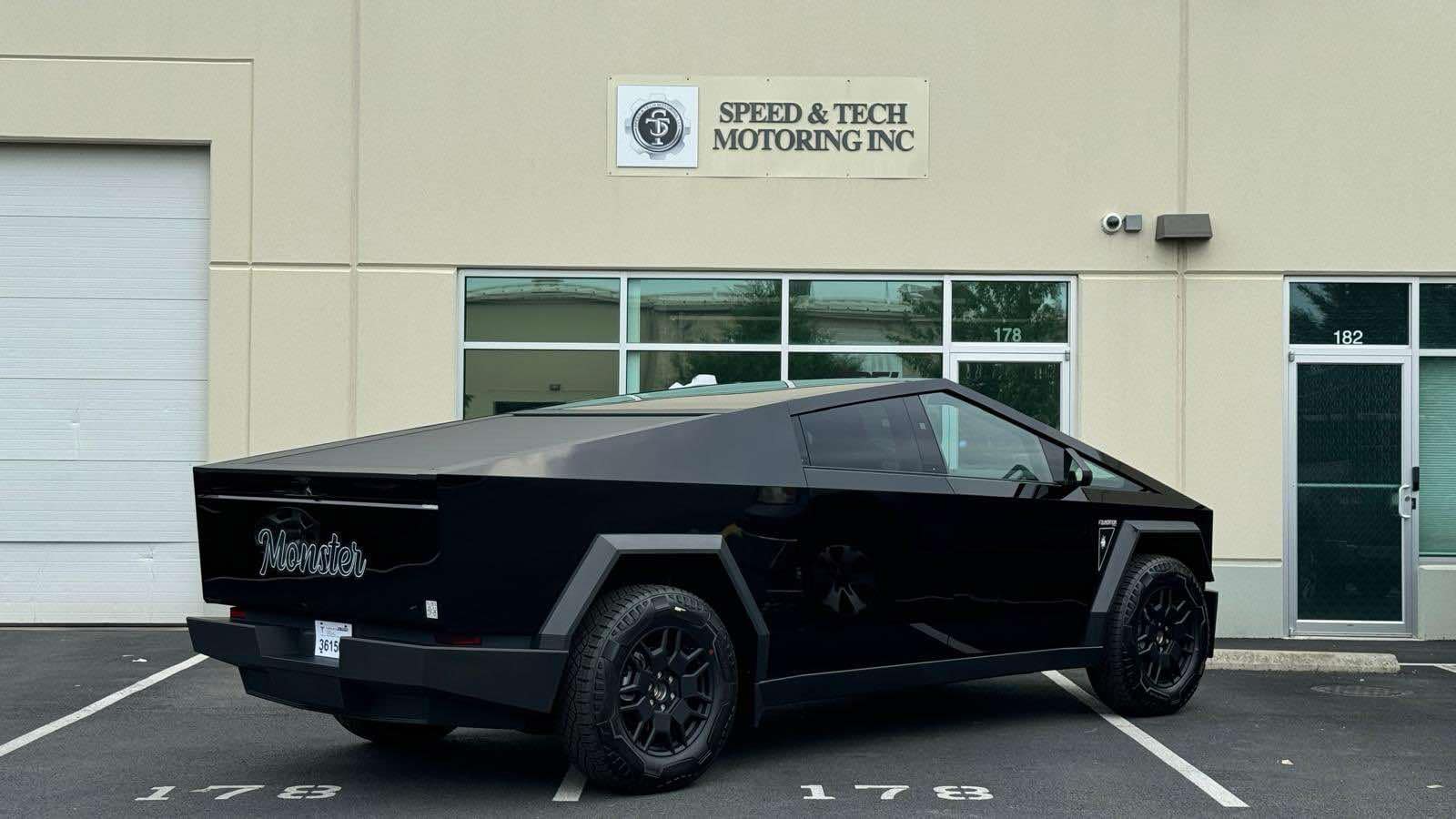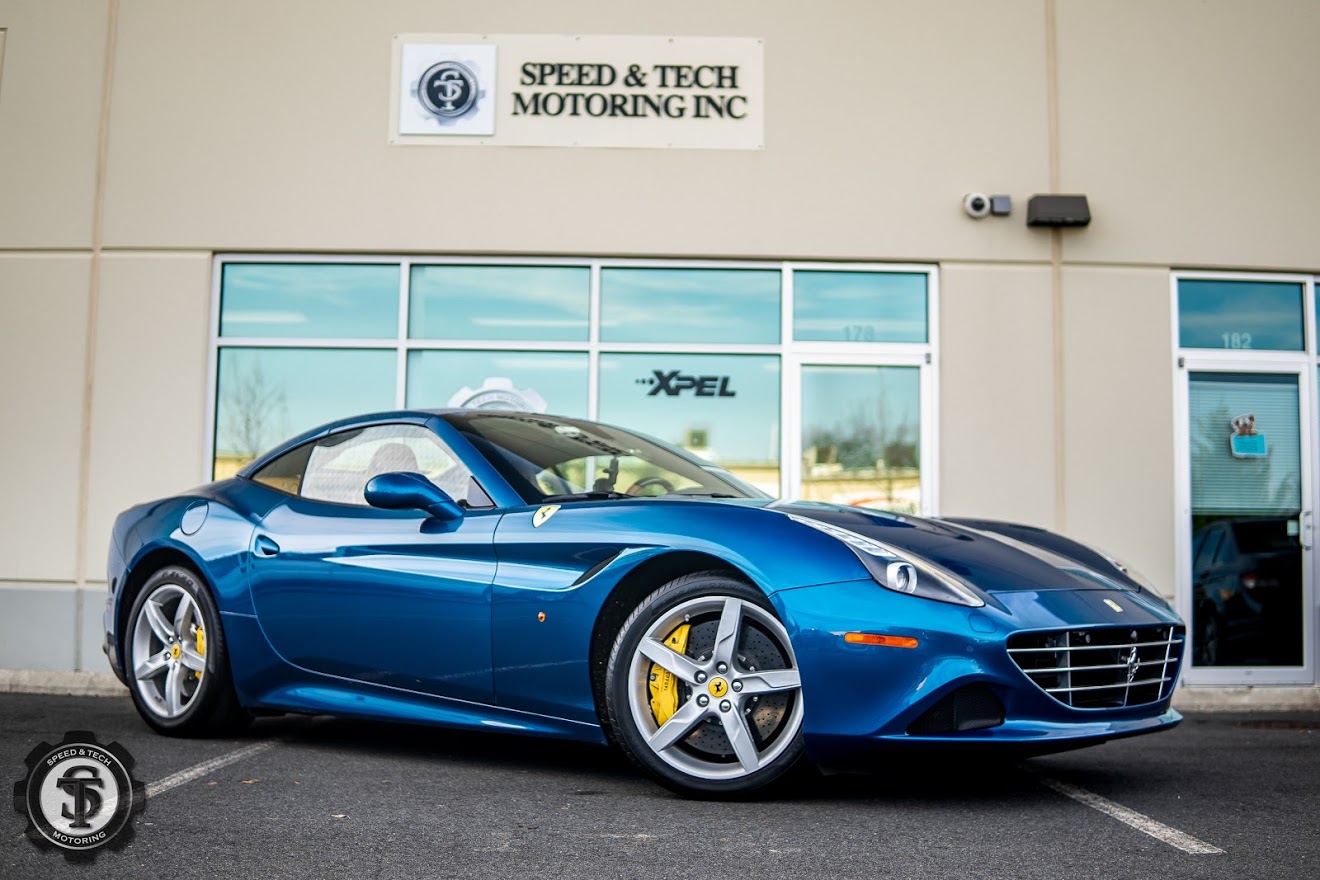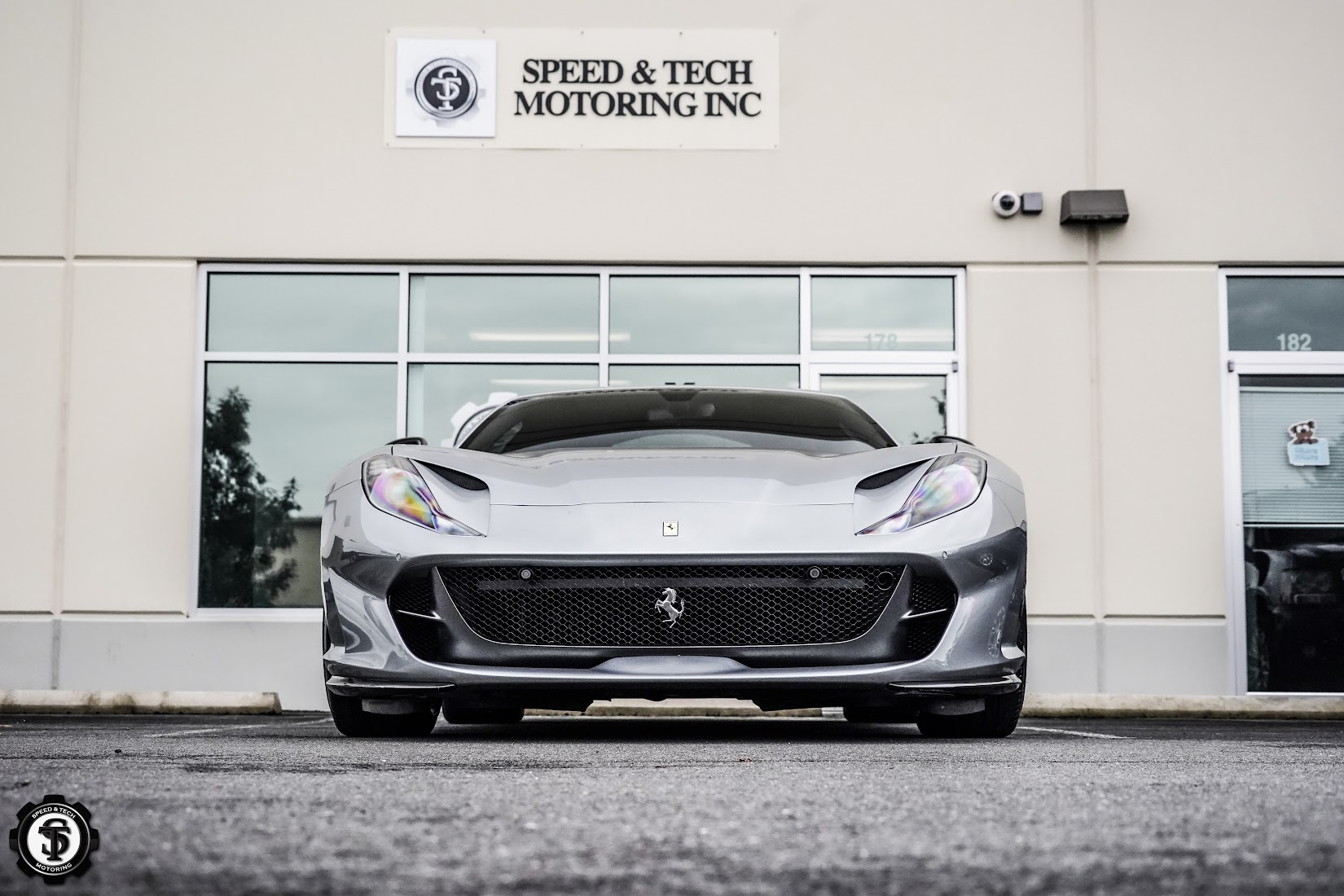You’ve probably experienced that uncomfortable feeling when you’re stopped at a traffic light and notice people in adjacent vehicles staring directly into your car. Maybe you’ve had valuable items visible on your seats that you’d rather keep hidden from passersby. Or perhaps you simply value your personal space and dislike feeling like you’re in a fishbowl whenever you drive. These common concerns drive many vehicle owners toward window tinting, but a critical question always emerges: how can darkened windows provide privacy without making it dangerous to see out, especially at night?
This balance between privacy and visibility represents one of the most sophisticated aspects of modern window tinting technology. The films accomplish something that seems almost contradictory—creating a strong barrier against outside observation while maintaining clear outward visibility for the driver and passengers. Understanding how this works involves examining the physics of light transmission, the specific properties of different film types, and the practical considerations that determine whether a particular tint level suits your needs. Professional installers like Speed & Tech Motoring routinely guide vehicle owners through these decisions, helping them find the sweet spot where privacy and safety coexist comfortably.
The Privacy Paradox in Modern Vehicles
Before diving into how window tinting achieves its dual purpose, it helps to understand why this balance matters and what challenges it presents.
Why Privacy Matters in Your Vehicle
Your vehicle serves as a personal space where you spend significant time—commuting, running errands, traveling, or simply waiting. This space contains your belongings, your conversations, your children, and your activities. The ability to maintain privacy in this mobile environment affects your comfort, security, and peace of mind in ways that extend beyond simple preference.
Privacy concerns aren’t just about vanity or antisocial tendencies. They involve practical security considerations like preventing smash-and-grab thefts by concealing valuables from view. They include protecting children from unwanted attention. They encompass professional needs for business travelers who take confidential calls or review sensitive documents in their vehicles. Privacy also simply makes most people feel more comfortable and relaxed, reducing the self-consciousness that comes with constant visibility.
The Visibility Challenge
However, privacy cannot come at the expense of safety. Drivers must maintain clear visibility in all directions to operate vehicles safely. This means seeing through windows clearly enough to monitor traffic, pedestrians, road conditions, and potential hazards. The visibility requirement becomes even more critical during nighttime driving, in adverse weather, or in poorly lit areas where every bit of available light matters.
This creates the fundamental challenge: how do you make it difficult for others to see into your vehicle while ensuring you can see out clearly? The answer lies in understanding that visibility works differently from different perspectives and under different lighting conditions—and window tinting exploits these differences strategically.

Understanding Light Transmission in Window Films
The foundation of privacy-enhancing window tinting lies in controlling how light passes through the film in different directions and under varying conditions.
Visible Light Transmission Explained
Visible Light Transmission, or VLT, measures the percentage of visible light that passes through a window film. A film with 50% VLT allows half the visible light through, while a 20% VLT film permits only one-fifth of light to pass. This measurement directly determines both how dark the window appears from outside and how much light reaches the interior.
Here’s where the interesting part begins: VLT affects inward and outward visibility differently depending on lighting conditions. During daylight hours, the bright exterior environment contains far more light than your vehicle’s interior. When you look out through even a fairly dark film, you’re looking from a relatively dim space toward a bright space, and your eyes easily see through the tint. However, someone outside trying to look in faces the opposite situation—they’re looking from brightness into dimness through a light-reducing barrier, making it very difficult to see interior details.
The One-Way Mirror Effect
This phenomenon creates what many people recognize as the “one-way mirror” effect, similar to interrogation rooms in police shows. The effect isn’t truly one-way in the sense that light only travels in one direction—it’s about the dramatic difference in lighting levels on each side of the glass. Window tinting amplifies this natural effect by reducing the amount of light passing through, making the contrast between exterior and interior lighting even more pronounced.
The darker your tint, the stronger this privacy effect becomes during daylight. A 35% VLT film provides moderate privacy, making it somewhat difficult to see clear details inside but not impossible. A 20% VLT film creates strong privacy where interior details become very difficult to discern. A 5% VLT film—often called “limo tint”—makes it nearly impossible to see anything inside during daylight hours.
How Darkness Levels Create Privacy
Different tint darkness levels create dramatically different privacy and visibility experiences, both for you and for outside observers.
Light to Dark Tint Percentages
Window Tinting Sterling VA darkness typically ranges from 50% VLT (light tint) down to 5% VLT (extremely dark). Each level serves different purposes and creates different privacy/visibility balances. Understanding these levels helps you select appropriate darkness for your specific needs.
A 50% VLT tint provides minimal privacy—people can still see inside relatively easily, but you gain heat reduction and UV protection. At 35% VLT, privacy improves noticeably; casual observers struggle to see clear details inside, though someone who looks carefully can still make out shapes and movements. At 20% VLT, privacy becomes strong; interior details become very difficult to discern in most lighting conditions. At 5% VLT, privacy is nearly absolute during daylight, with virtually no interior visibility from outside.
Daytime Privacy Performance
During bright daylight conditions, window tinting performs at its privacy-enhancing peak. The high ambient light levels outside create the maximum contrast with your vehicle’s darker interior. Even moderate tint levels like 35% VLT provide reasonable privacy under these conditions, while darker films create essentially complete visual barriers.
The privacy effectiveness also depends on the brightness of your interior. If your interior is very light-colored and sunlight is streaming in through untinted windows, even dark side window tinting won’t be as effective. Conversely, if your interior is dark and other windows are also tinted, the privacy effect strengthens considerably. This is why comprehensive window tinting that covers multiple windows often provides better overall privacy than tinting just one or two windows.
Nighttime Visibility Considerations
The privacy equation reverses at night. When it’s dark outside and your interior lights are on, people outside can see into your vehicle more easily—even through tinted windows. The interior becomes the bright space while the exterior is dark, reducing the privacy advantage that tinting provides during daylight.
However, tinting still provides meaningful nighttime privacy compared to untinted glass, especially when interior lights are off or dimmed. Additionally, very dark tint (below 20% VLT) can make it somewhat challenging to see out clearly at night, particularly in poorly lit areas. This is why many people choose moderate tint levels (35-50% VLT) for front side windows used for critical visibility while opting for darker tint (20% VLT or lower) on rear and rear side windows where nighttime outward visibility matters less.

Reflective Properties and Privacy Enhancement
Beyond simple darkness, some window tinting films incorporate reflective properties that enhance privacy through a different mechanism.
How Reflective Films Work
Reflective or metalized window tinting contains metallic particles that reflect light away from the glass rather than allowing it to pass through. This creates a mirror-like appearance from the outside while maintaining reasonable clarity from inside. The reflective property works independently of darkness level, though the two characteristics often combine in the same film.
The privacy advantage of reflective films is that they actively prevent light from penetrating the glass by bouncing it back toward its source. This makes it even more difficult for outside observers to see through the windows, as not only is less light making it through, but their own reflected environment gets in the way of seeing what’s beyond the glass.
Exterior Reflection vs Interior Clarity
The engineering challenge with reflective films involves creating strong exterior reflection while maintaining clear outward visibility from inside. Quality reflective films achieve this through precise construction that positions reflective layers strategically within the film’s structure. The result is a film that looks like a mirror from outside but remains reasonably clear from the interior perspective.
Some regions have legal restrictions on how reflective window tinting can be, as excessive reflectivity can create visibility problems for other drivers by reflecting bright sunlight or headlights. These regulations typically limit reflectivity to specific percentages. When considering reflective films, consulting with experienced professionals ensures you remain within legal limits while maximizing privacy benefits.
Viewing Angles and Privacy Protection
The effectiveness of window tinting for privacy also depends significantly on viewing angles—how directly someone is looking at your windows.
Direct Line of Sight Blocking
Window tinting excels at blocking direct line-of-sight viewing, where someone is positioned at roughly the same height as your windows and looking straight at them. This represents the most common privacy invasion scenario—people in adjacent vehicles, pedestrians on sidewalks, or passersby in parking lots glancing into your car. Under these conditions, even moderate tinting provides substantial privacy, making it difficult to discern details inside.
The viewing angle effect explains why tinted windows appear darker and more opaque when viewed straight-on compared to at sharp angles. The light must pass through more tint material when entering at perpendicular angles versus shallow angles, increasing the privacy effect. This geometric property of window films enhances privacy exactly where it matters most—when people are positioned to look directly into your vehicle.
Peripheral Vision Limitations
However, tinting becomes less effective at extreme angles. If someone positions themselves very close to your window and looks at a sharp angle, they can sometimes see through even relatively dark tint. This physical reality means window tinting isn’t an absolute privacy solution—it’s very effective for normal viewing situations but not completely impenetrable under all circumstances.
For most practical purposes, this limitation doesn’t significantly impact privacy effectiveness. The overwhelming majority of privacy concerns involve normal viewing distances and angles where tinting performs excellently. Situations where someone would press close to your window at an extreme angle are rare and obvious, allowing you to respond appropriately.
Different Tint Types and Privacy Performance
The various window tinting technologies each bring unique characteristics to the privacy-visibility equation.
Ceramic Films for Balanced Privacy
Ceramic window tinting creates privacy primarily through darkness level rather than reflectivity, as these films typically have minimal mirror-like appearance. The advantage is that ceramic films maintain excellent clarity from inside even at darker VLT levels. The advanced nano-ceramic technology allows these films to be quite dark while still providing good outward visibility.
This makes ceramic films ideal for people who want strong privacy without the reflective appearance or who need to maintain optimal nighttime visibility. A 35% ceramic film provides excellent daytime privacy while remaining comfortable for night driving. Even 20% ceramic films maintain reasonable visibility under most conditions thanks to their optical clarity.
Carbon Films and Visual Obstruction
Carbon window tinting also relies primarily on darkness for privacy rather than reflection, creating a matte black appearance that many find aesthetically appealing. Carbon films provide excellent privacy proportional to their VLT rating, and like ceramic films, they maintain good clarity for outward viewing.
The matte finish of carbon films means they don’t create glare or reflection issues that some reflective films can produce. This makes them practical choices for drivers who want privacy without any mirror effects. The trade-off is that without reflective properties, you’re relying entirely on darkness level for privacy, which may require darker VLT percentages to achieve desired privacy levels.
Metalized Films and Mirror Effects
Metalized window tinting creates privacy through both darkness and reflection, as the metallic particles naturally reflect light. This combination can provide excellent privacy even at somewhat lighter VLT percentages compared to non-reflective films. A 35% reflective film might provide similar privacy to a 25% non-reflective film because of the additional barrier that reflection creates.
The reflective appearance isn’t for everyone aesthetically, but it undeniably enhances privacy. The mirror-like exterior makes it significantly harder for people to see inside while you maintain clear outward visibility. If privacy ranks as your top priority and you don’t mind the reflective look, metalized films deliver excellent results.
Strategic Window Selection for Privacy
Maximizing privacy while maintaining safety often involves different tint levels on different windows rather than uniform darkness throughout.
Front vs Rear Window Tinting
Most regions have stricter regulations for front side windows and windshields compared to rear windows, precisely because driver visibility is most critical from these positions. This legal framework actually aligns well with practical privacy considerations. You can often apply darker tint to rear and rear side windows where privacy matters but outward visibility is less critical for driving safety.
A common approach involves keeping front side windows at legal limits (often 35-50% VLT) while going darker on rear side and rear windows (20-35% VLT or even darker where legal). This provides strong overall privacy, especially for rear seat passengers and cargo areas, while maintaining optimal visibility for the driver.
Side Window Privacy Solutions
Side windows present the most significant privacy concerns since they’re most visible to people in adjacent vehicles and pedestrians. Fortunately, side windows also typically allow darker tinting than windshields, creating opportunities for meaningful privacy enhancement.
Driver and Passenger Window Considerations
Driver and front passenger windows require the most careful balance between privacy and visibility. These windows are essential for checking blind spots, monitoring traffic, and assessing your surroundings. Most drivers find that 35-50% VLT provides a good balance—enough darkness to create meaningful daytime privacy while maintaining excellent visibility for safe driving.
Some drivers prefer matching front and rear side window darkness for uniform appearance, while others prioritize maximum legal darkness on all windows. Consulting with experienced professionals like Speed & Tech Motoring helps you evaluate these options based on your specific vehicle, local regulations, and personal preferences.
Interior Visibility Maintenance
While we focus heavily on privacy, we can’t forget that your ability to see out clearly remains paramount for safe vehicle operation.
Outward Visibility Through Tinted Windows
From inside your vehicle looking out, window tinting typically has minimal impact on visibility during daylight hours, even at fairly dark VLT levels. Your eyes adapt remarkably well to the reduced light level, and the brightness of the exterior environment compensates for the light reduction. Many people report that they quickly forget their windows are tinted because the view out remains clear and natural.
Nighttime outward visibility changes the equation. Very dark tint (below 20% VLT) can make it challenging to see clearly in dark, poorly lit areas. This is why most people choose moderate tint levels for front side windows where nighttime visibility matters most for safe driving. Rear windows can be darker since you primarily use them during daylight backing maneuvers or through mirrors where even dark tint don’t significantly impair visibility.
Dashboard and Instrument Panel Clarity
Quality window tinting should not interfere with your ability to see your dashboard, instrument panel, or center console displays. Properly installed films on side windows don’t affect these views since they’re not in your line of sight to the dashboard. Even front windshield tint strips (where legal) are positioned above the driver’s normal sight line to avoid interference with instrument visibility.
Some people worry that darker interior environments from tinting might make screens harder to see, but the opposite is often true. Reduced glare from tinting can actually improve screen visibility by reducing competing light that washes out displays. Many drivers find their navigation systems and digital dashboards easier to read after tinting.
Rearview Mirror and Backup Camera Functionality
Modern vehicles rely heavily on rearview mirrors and backup cameras for safe operation. Window tinting on rear windows can affect what you see through your rearview mirror, making it slightly dimmer. However, this rarely creates practical problems because exterior brake lights, headlights, and ambient lighting provide sufficient illumination for safe operation.
Backup cameras work independently of window tinting since they’re external devices capturing images directly rather than through tinted glass. However, if you have a rear camera mounted inside looking through the rear window (less common), very dark tinting could reduce image quality. Most backup cameras are external and completely unaffected by tinting.
Legal Compliance and Privacy Balance
Window tinting regulations exist specifically to ensure drivers maintain adequate visibility while allowing reasonable privacy.
Understanding VLT Requirements
Different regions have different legal limits for how dark window tinting can be on various windows. These regulations typically specify minimum VLT percentages for front side windows, rear side windows, and rear windows, with windshields often having the strictest limitations or prohibitions on tinting.
Understanding your local regulations is essential before selecting tint darkness. Legal limits represent tested thresholds where authorities have determined visibility remains adequate for safe driving. Staying within these limits ensures you avoid tickets while maintaining the privacy-visibility balance that regulations intend.
Windshield Restrictions
Most regions prohibit windshield tinting entirely or allow only a strip across the top portion. These restrictions exist because windshield visibility is absolutely critical for safe driving—it’s your primary view of the road ahead. Even minor visibility reductions can impact reaction time and hazard detection.
While this means you can’t achieve the same privacy for front seat occupants that rear seat passengers enjoy, you can still gain meaningful privacy through properly tinted side and rear windows. The combination of moderate front side window tinting with darker rear tinting creates reasonable overall privacy while maintaining critical forward visibility.
Lighting Conditions and Privacy Effectiveness
Window tinting privacy performance varies dramatically depending on environmental lighting conditions.
Bright Sunlight Performance
Window tinting performs at its absolute best for privacy during bright, sunny conditions. The intense exterior light creates maximum contrast with your vehicle’s darker interior, making it extremely difficult for outside observers to see through tinted windows. Even moderate tint levels provide excellent privacy under these conditions.
This is exactly when most people value privacy most—sitting in traffic, parked in busy areas, or driving through crowded streets during daytime. The times when you feel most exposed coincide perfectly with when tinting provides maximum privacy benefits.
Overcast and Low Light Scenarios
During overcast days or early morning and late afternoon when light levels are lower, tinting privacy effectiveness decreases somewhat compared to bright sunlight. The reduced contrast between exterior and interior brightness makes it slightly easier to see through tinted windows. However, tinting still provides meaningful privacy advantages compared to untinted glass even under these conditions.
The degree of privacy reduction in low light depends on tint darkness. Darker tint (20% VLT and below) maintain strong privacy even in overcast conditions, while lighter tint (35-50% VLT) show more noticeable privacy reduction when ambient light dims.
Evening and Night Driving
Nighttime represents the most challenging scenario for window tinting privacy, as the lighting dynamics reverse. If your interior lights are on, people outside can see in more easily regardless of tint darkness. However, most people drive with interior lights off at night, which restores significant privacy benefits even through tinted windows.
The key consideration for nighttime isn’t privacy but rather your ability to see out. This is why choosing appropriate tint darkness for front side windows matters so much—you need to balance daytime privacy benefits with nighttime visibility requirements. Most experienced drivers find that 35% VLT or lighter provides the best balance for front windows used in nighttime driving.
Privacy for Specific Use Cases
Different vehicle uses and circumstances create different privacy needs and optimal tinting approaches.
Family Vehicle Privacy Needs
Families often prioritize privacy for children and want to create comfortable environments where kids can relax without feeling observed. Window tinting provides excellent solutions for these needs. Darker tint on rear side windows and rear windows create private spaces for car seats and children while maintaining driver visibility through appropriately tinted front windows.
This approach also helps children sleep during long trips by reducing brightness and creates more comfortable environments for everyone by reducing sun exposure and heat. The privacy aspect simply adds to the overall family comfort that quality window tinting provides.
Business and Professional Applications
Professionals who work from their vehicles need privacy for phone calls, video conferences, document review, and other business activities. Window tinting transforms your vehicle into a mobile private office where you can work confidently without worrying about passersby viewing sensitive information or overhearing conversations.
The privacy benefits extend to impression management as well. Tinted windows convey professionalism and seriousness that aligns with business use. They also protect valuable equipment like laptops and tools from view, reducing theft risk when you must leave items in your vehicle.
Personal Security Considerations
For people with security concerns—whether based on professional roles, personal circumstances, or simply being cautious—window tinting provides meaningful security benefits through privacy. By concealing who’s in the vehicle, how many occupants it contains, and what valuables might be present, tinting reduces your profile as a potential target.
Dark tinting can also provide psychological comfort for people who feel anxious or unsafe in certain situations. The sense of enclosure and privacy that tinting creates helps some people feel more secure and relaxed while driving or parked.
Maintaining Clear Sight Lines While Private
The ultimate goal is finding the sweet spot where you feel appropriately private without sacrificing the visibility you need for safe, confident driving.
Optimal Tint Percentages for Balance
For most drivers, 35% VLT on front side windows provides excellent balance. This darkness creates meaningful daytime privacy while maintaining very good nighttime visibility. Combined with 20% VLT or darker on rear side and rear windows, you achieve strong overall privacy while keeping critical sight lines clear.
However, individual preferences vary. Some people feel comfortable with darker front tint (down to legal limits) and adapt well to slightly reduced nighttime visibility. Others prefer lighter front tint (50% VLT) and rely on darker rear tint for privacy. The key is understanding these trade-offs and making informed choices based on your specific needs and driving patterns.
Professional Assessment and Recommendations
Experienced window tinting professionals have installed thousands of tint and understand exactly how different darkness levels perform in real-world conditions. They can show you examples, discuss your specific concerns, and recommend combinations that achieve your goals while maintaining safety and legal compliance.
Facilities like Speed & Tech Motoring take the time to understand your priorities—whether privacy, heat reduction, UV protection, or aesthetics rank highest—and guide you toward solutions that deliver what matters most to you. This expertise ensures you don’t have to guess or experiment but instead benefit from proven approaches that balance privacy and visibility effectively.
Speed & Tech Motoring Serving the Windmill Farm Community and Beyond in North Potomac, MD
Speed & Tech Motoring is dedicated to serving the diverse needs of the local community of North Potomac, MD, including individuals residing in neighborhood like Windmill Farm With its convenient location near landmarks such as the Aberdeen Local Park, Muddy Branch Trail Head and major intersections like Quince Orchard Rd & Jones Ln and Dufief Mill Rd & Travilah Rd (coordinates: 39.09917091334859, -77.26860831556534), we offer window tinting services.
Get Window Tinting Services at Windmill Farm Now
Navigate from Windmill Farm to Speed & Tech Motoring Now
Which Window Tinting Technologies Enhance Privacy Without Darkness?
- Privacy-Enhancing Films with High Visible Light Transmission (VLT):
- Dual-reflective and ceramic films maintain VLT above 40%, allowing natural light while obscuring outside view during daytime.
- Frosted and decorative films provide daytime privacy without darkening interiors.
- Key Performance Statistics:
- Window films can block up to 99% of UV rays and up to 97% of infrared radiation, reducing heat without heavy tinting.
- Privacy films reduce exterior visibility by 60-80% during daylight while preserving interior brightness.
- High VLT films (≥40%) balance privacy and clarity, unlike traditional dark tint (<35% VLT) which reduce visibility inside.
- Energy & Comfort Benefits:
- Window films reduce solar heat gain by up to 60%, improving comfort without darkening rooms.
- Energy savings up to 30-50% on cooling costs reported with advanced films that enhance privacy and light transmission.
- Market Trends:
- The global window film market valued at $11.56 billion in 2023, growing at 5.3% CAGR, driven by demand for privacy and energy-efficient films.
- Automotive and residential privacy films increasingly use ceramic and dual-reflective technologies for privacy without darkness.
Visual suggestion: A bar chart comparing common window tint types by Visible Light Transmission (%) vs. Privacy Effectiveness (% reduction in outside visibility), highlighting dual-reflective and ceramic films as optimal privacy solutions with high VLT.
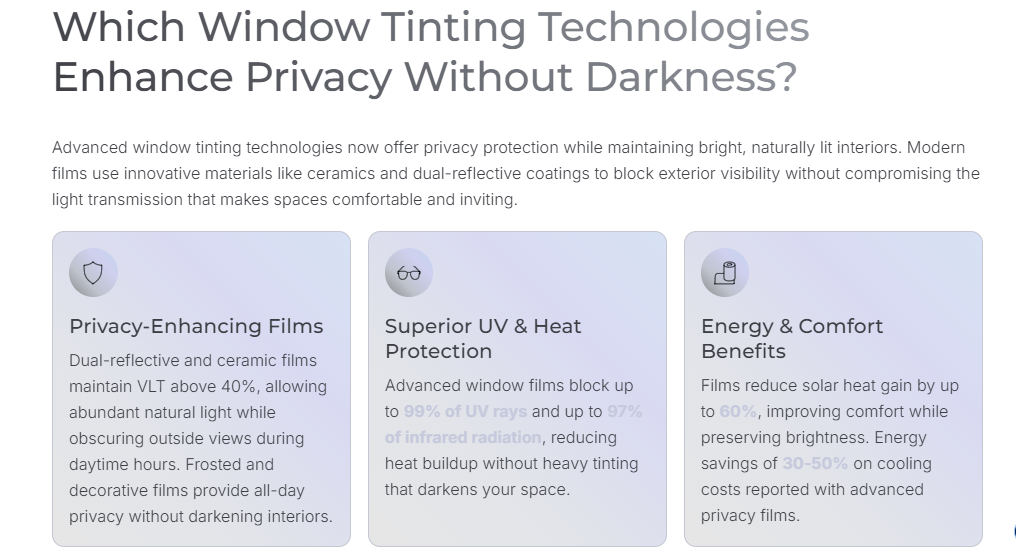

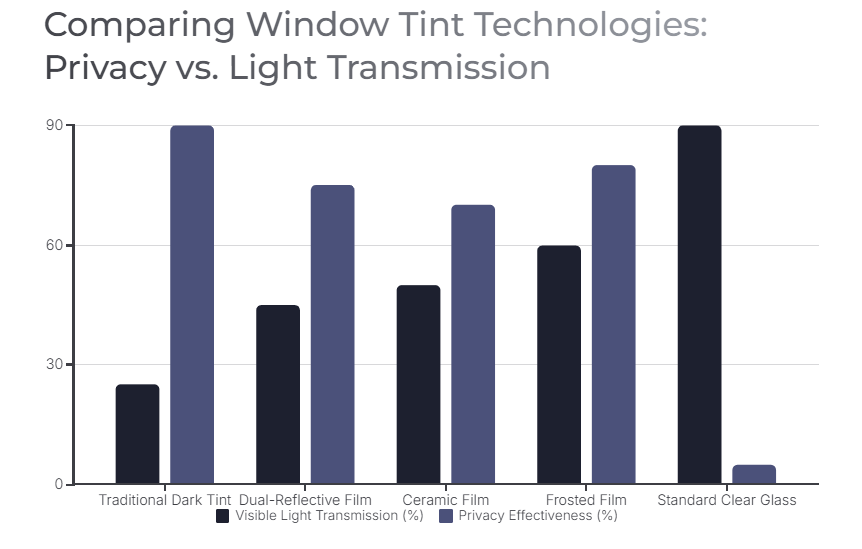
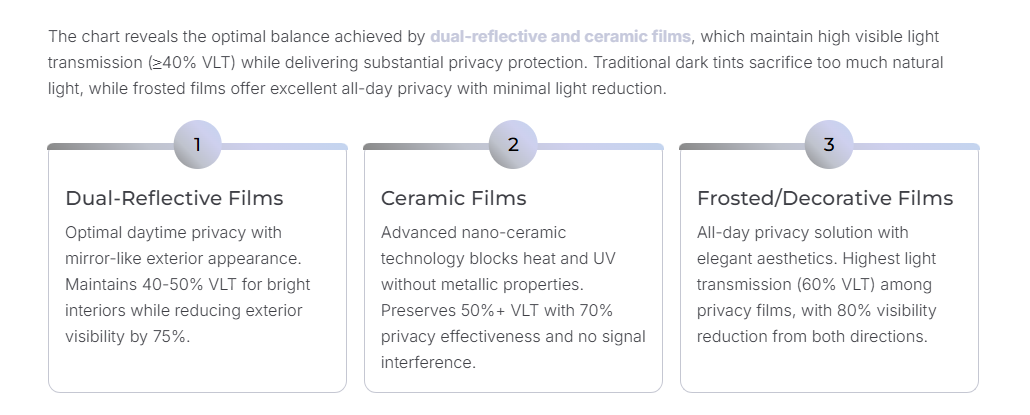
Sources: Grand View Research (2023), Custom Tint Solutions, Clear Cut Glass (2025)
Window tinting achieves what seems paradoxical at first glance: it creates strong privacy barriers that make it difficult for others to see into your vehicle while preserving your clear outward visibility for safe driving. This balance works through the physics of light transmission, where the difference between bright exterior and darker interior creates natural one-way visibility that tinting amplifies. During daylight hours when privacy matters most, even moderate tint levels make interior details very difficult to discern from outside while your view out remains clear and unobstructed.
FAQs
What VLT percentage provides the best balance between privacy and nighttime visibility?
For most drivers, 35% VLT represents the optimal balance on front side windows. This darkness creates strong daytime privacy by making it difficult for people to see interior details, while maintaining excellent nighttime visibility for safe driving. Darker tint like 20% VLT can work well on rear windows where nighttime outward visibility is less critical. Individual preferences vary, but 35% VLT on front windows combined with 20% VLT or darker on rear windows gives most people the privacy they want while keeping critical sight lines clear.
Can people see into my car at night through tinted windows?
Yes, but less easily than through untinted windows. At night, if your interior lights are on, tinting loses much of its privacy advantage since you’re now the bright space and outside is dark. However, with interior lights off, tinted windows still provide meaningful privacy even at night. The reversal of lighting conditions means nighttime privacy is never as complete as daytime privacy, but tinting still makes it significantly harder for people to see inside compared to untinted glass.
Does reflective tinting provide more privacy than non-reflective dark tinting?
Reflective tinting can provide excellent privacy even at somewhat lighter VLT percentages because it actively bounces light away rather than just absorbing it. A 35% reflective film might provide similar privacy to a 25% non-reflective film. However, very dark non-reflective films (20% VLT or lower) generally provide equal or better privacy than reflective films. The choice often comes down to aesthetics and legal restrictions, as some regions limit reflectivity levels. Both approaches can deliver strong privacy when darkness levels are chosen appropriately.
Will window tinting make it harder to see my rearview mirror or backup camera?
Window tinting on rear windows will slightly reduce the brightness of what you see through your rearview mirror, but this rarely creates practical problems for safe driving. Your eyes adapt quickly, and vehicle lights provide sufficient illumination for mirror use. Backup cameras are typically external devices that work independently of window tinting, so rear window tinting doesn’t affect camera functionality. The slight dimming of rearview mirrors is a minor trade-off for the privacy and other benefits that tinting provides.
How dark can I legally tint my windows while still maintaining enough privacy?
Legal limits vary by region but typically allow 35-50% VLT on front side windows, with more flexibility for rear windows. These legal limits are designed to maintain adequate driver visibility while permitting meaningful privacy. In most cases, tinting to the legal limit on front windows combined with darker tint on rear windows (where more flexibility usually exists) provides excellent overall privacy. Consulting local regulations and working with experienced installers ensures you maximize privacy while staying within legal requirements that protect both your safety and others on the road.
Our Other Blog Posts Related Window Tinting
How Window Tinting Films Differ And Their Unique Benefits
How Window Tinting Protect Car Upholstery And Interior Quality
What Window Tinting Options Provide Strongest UV Defense
How Long Does Window Tinting Last? Expert Tips to Extend Its Life

